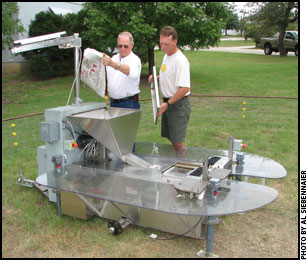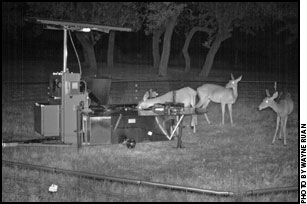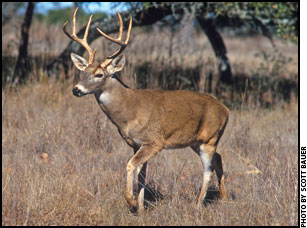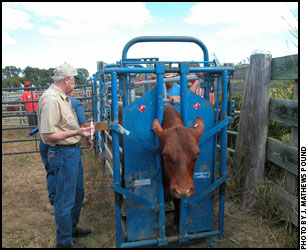Ridding the Texas-Mexico Border of Cattle Fever Ticks
Reemergence of disease-carrying ticks could cause devastating monetary losses for U.S. beef and dairy producers.
Bovine babesiosis, commonly known as "Texas cattle fever," is a deadly disease of cattle caused by single-celled organisms that are transmitted by cattle fever ticks. Texas cattle fever greatly harmed the cattle industry in the United States until the beginning of the 20th century.
Thanks to highly effective and collaborative control efforts established through the Cattle Fever Tick Eradication Program (CFTEP) in 1906 between producers and state and federal agencies, cattle fever ticks were largely eradicated from this country by 1943. As a result, the United States became free of Texas cattle fever, but cattle fever ticks still thrive in Mexico. CFTEP established a permanent quarantine or "buffer" zone along the Texas-Mexico border to keep the ticks out of the United States. But these potentially disease-carrying ticks — Rhipicephalus (Boophilus) microplus and R. annulatus — are now reinfesting Texas outside of the quarantine zone, thus increasing the risk of outbreaks of Texas cattle fever. Its reemergence could cause devastating monetary losses for U.S. beef and dairy producers.

Entomologist Mat Pound (left) and technician Wayne Ryan load corn, used as bait to attract deer, into the hopper of an automatic deer-collaring device.
Agricultural Research Service (ARS) scientists in Kerrville, Texas, are developing and testing new interventions to eliminate cattle fever ticks within our borders and mitigate the impact on the U.S. livestock industry.
Once gone, but they're back
"Keeping cattle fever ticks eradicated from the United States, and thus keeping the national cattle herd free of cattle fever, is a current and critical agricultural biosecurity issue of national importance. Bovine babesiosis is listed by the World Organization for Animal Health as a notifiable disease," says Adalberto Pérez de Léon, director of the Knipling-Bushland U.S. Livestock Insects Research Laboratory in Kerrville. "CFTEP personnel are the only ones who can officially detect and report cattle fever tick infestations, which triggers statutory procedures for eradication. It is estimated that the livestock industry currently saves at least $3 billion annually as a result of the eradication of Texas cattle fever and cattle fever ticks.

This is an infrared image of a doe in position to be collared at night.
"The number of cattle fever tick outbreaks inside and outside of the permanent quarantine zone fluctuates over time. It took six years to accomplish reeradication after a significant incursion by ticks into the United States in the 1970s. During the last five years, the level of cattle fever tick activity in the United States has again increased to alarming levels."
The increased spread of infestation is likely due, at least in part, to the growing populations of white-tailed deer and other wild ungulates along the Texas-Mexico border. ARS entomologist J. Mathews Pound and his colleagues at the Kerrville laboratory have intensively studied the impact white-tailed deer have on the cattle fever tick population and developed interventions to eradicate the ticks from the country.
Deer complicate eradication efforts
Early in the fever-tick eradication program, white-tailed deer weren't a concern because they were rare in the southern United States. Cattle were dipped in insecticides to kill the ticks, but the ticks eventually found another host as the deer population grew.

A population explosion of white-tailed deer in parts of the United States has increased the risk of transmission of some diseases.
"Native and nonnative species of wild ungulates figure prominently among the likely causes for the apparent reinvasion of the United States by cattle fever ticks," Pound says. "White-tailed deer are regarded as the major complicating factor in current eradication efforts since they are suitable hosts for cattle fever ticks. Removing cattle from infested pastures was a viable eradication method in past years, but now it's unlikely to be effective as long as white-tailed deer remain within an area."
To control disease-carrying ticks on deer, Pound and his colleagues developed a device called the "4-Poster Deer Treatment Bait Station" (see Agricultural Research, June 2006, pp. 8-9). It lures deer into a feeding apparatus that uses rollers to apply insecticide to the animal's head, ears, and neck. As the deer grooms, it transfers insecticide to other parts of its body, killing most of the ticks on the animal. The current research project Pound leads at the Kerrville laboratory focuses on the development of technologies to eradicate ticks on cattle and wild deer.
Microspheres and collars do the job
Currently, producers with infested pastures must round up and dip their cattle in insecticide every two weeks for nine months until no ticks remain in the pasture. A less labor-intensive and cheaper way to rid the pasture of ticks is needed.
In efforts to help cattle producers, Pound and his colleagues reformulated a broad-spectrum antiparasitic medication — doramectin — into an injectable microsphere treatment.

Allen Miller (retired ARS agricultural engineer) prepares to inject doramectin-impregnated microspheres developed by ARS into a bull to protect it from tropical bont ticks, known to transmit the potentially fatal heartwater disease on the island of Saint Croix, U.S. Virgin Islands.
"A single injection of microspheres — akin to time-release capsules in human drugs — greatly reduces the number of treatments needed and protects cattle for up to four months, killing parasites and saving cattle ranchers considerable expense. The technology shows great potential for helping to maintain the eradication of fever ticks from the United States," Pound says.
"The treatment has been tested with excellent results on the island of Saint Croix against the tropical bont tick, which transmits a disease called “heartwater” to cattle. We are working to extend the effective period to six months, which would be most useful in treating U.S. cattle for ticks."
Partners for commercializing this technology are being sought.
Heartwater disease causes an acute high fever, loss of appetite, and respiratory distress. It progresses to include excessive chewing motion, eyelid twitching, galloping movements, and eyes rolling back. Death can occur in less than one week.
To provide an alternative to the 4-Poster device for treating white-tailed deer, Pound and co-inventor Craig LeMeilleur created a new system that can automatically apply pesticide-impregnated neckbands to wild deer in a bait station apparatus much like the 4-Poster. Instead of rollers, the device has an assembly for holding a collar in an open position and a trigger that applies the collar when a deer places its neck over the trigger support.
The automatic collaring device was patented by ARS in 1999, and is now in its fifth generation of development. The collars can be detached remotely after the insecticide's effectiveness wears off.
 A population explosion of white-tailed deer throughout the eastern United States has increased the risk of diseases transmitted to humans by different species of ticks. Technologies developed for control of cattle fever ticks on deer will also help control other deer-associated ticks, which transmit diseases such as Lyme disease, human babesiosis, and two kinds of ehrlichiosis.
A population explosion of white-tailed deer throughout the eastern United States has increased the risk of diseases transmitted to humans by different species of ticks. Technologies developed for control of cattle fever ticks on deer will also help control other deer-associated ticks, which transmit diseases such as Lyme disease, human babesiosis, and two kinds of ehrlichiosis.
Editor's Note: This research is part of Animal Health (#103) and Veterinary, Medical, and Urban Entomology (#104), two ARS national programs described at www.nps.ars.usda.gov. J. Mathews Pound and Adalberto Pérez de Léon are with the USDA-ARS Knipling-Bushland U.S. Livestock Insects Research Laboratory, 2700 Fredericksburg Rd., Kerrville, TX 78028-9184; 830-792-0342. "Ridding the Texas-Mexico Border of Cattle Fever Ticks" was published in the November/December 2010 issue of Agricultural Research magazine.|
[Click here to go to the top of the page.]





